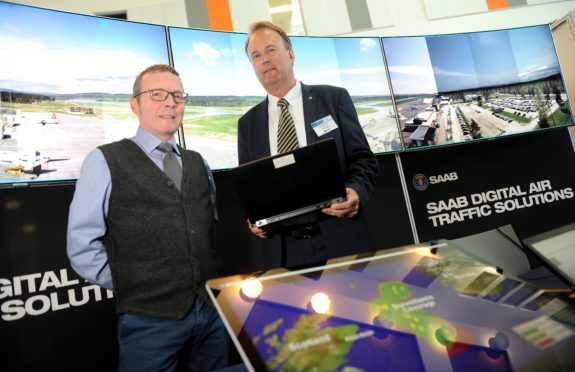The boss of Highlands and Islands Airports Ltd (Hial) has assured there will be no net job losses as a result of their plans to handle air traffic control for seven airports from a single site.
Managing director of the airport operator, Inglis Lyon, said 75 roles will be created over the next 10 to 15 years as the £28-30 million remote camera technology system is phased in.
He also revealed that a decision will be taken in July on the location for the new operations centre which would be at one of the Hial airports, including the possibiity of Dundee.
Mr Lyon spoke yesterday at a two day exhibition at the UHI campus in Inverness to showcase the technology from a number of leading industry players.
He said: “When we start the project there will be 75 staff affected and when we finish the number of jobs will remain exactly the same. This is not a cost-saving exercise.
“Once we decide on the location, we will work to minimise the impact on staff. There will be some staff coming up to retirement and some young members of staff who may want to transfer to the new site.”
Mr Lyon said the new technology is being brought in to “future proof” its operations in a context of challenges with staff recruitment and retention, increasing regulation in the industry, more air traffic demand and more pressures on costs.
He said the exhibition is about “demystifying” the product which has previously been criticised for potentially jeopardizing people’s safety. He added: “Our overriding priority is and will always be, to deliver safe and secure air navigation services that will keep our airports open for local communities for the long term.”
Swedish airports at Ornskoldsvik and Sundsvall became the first in the world to be controlled by digital tower control in Sundsvall in 2015.
Yesterday Per Ahl, vice president and head of marketing and sales for Saab Digital Air Traffic Solutions, assured that their systems in Sweden are designed to be resilient and comply with cyber security best practices.
He said that Saab even hired two different organisations to carry out mock cyber attacks – without being told when and how – on the system over a three month period and passed the test.
Mr Ahl added: “We take it very seriously and it’s a very important element of what we do. For Hial as a potential customer we would be able to hold their hands and re-use the experience from Sweden.”
The new operation centre will be responsible for air traffic management at Hial airports at Sumburgh in Shetland, Inverness, Wick, Kirkwall, Stornoway and Benbecula and Dundee.
Mr Lyon said that, after a decision is made in July, they will go to procurement and aim to have chosen a supplier after a year before moving ahead with installing the cameras.
Airports at Barra, Tiree, Islay and Campbeltown have different levels of air traffic usage and will not be affected by the changes.
More than 1.7 million people used Hial airports in 2017 and the Scottish Government-owned airport operator employs about 600 people at all of its 11 airports and head offices.
Benefits of the new technology
Michael Ellinger, tower automation product manager at Frequentis, one of the companies vying for Hial’s contract, explained the benefits of the technology over manned towers at yesterday’s event.
He said the remote technology enables a panoramic view of the airport in real time and an automatic tracking system labels aircraft while it takes off or lands. From the new operation centre, staff would be able to turn the view 360 degrees from a cursor on their desk and zoom in to observe further away aircraft.
A conventional air traffic controller would need to look out of the window with binoculars and needs to visualise everything three-dimensionally in their head based on traditional, two-dimensional monitors.
Mr Ellinger said that Frequentis is successfully using the technology in both Germany and Iceland, where he said weather conditions can be as unpredictable and varied as in the Highlands. He also said the remote cameras have all-weather protection and an automated cleaning function.
Frequentis is an international supplier of communication and information systems for air traffic control towers.
Other exhibitors at yesterday’s event included Saab and Avinor, a state limited company under the Norwegian Ministry of Transport, as well as Seabridge Technologies, a global leader in remote tower solutions and NATS, the main air navigation service provider in the UK.










